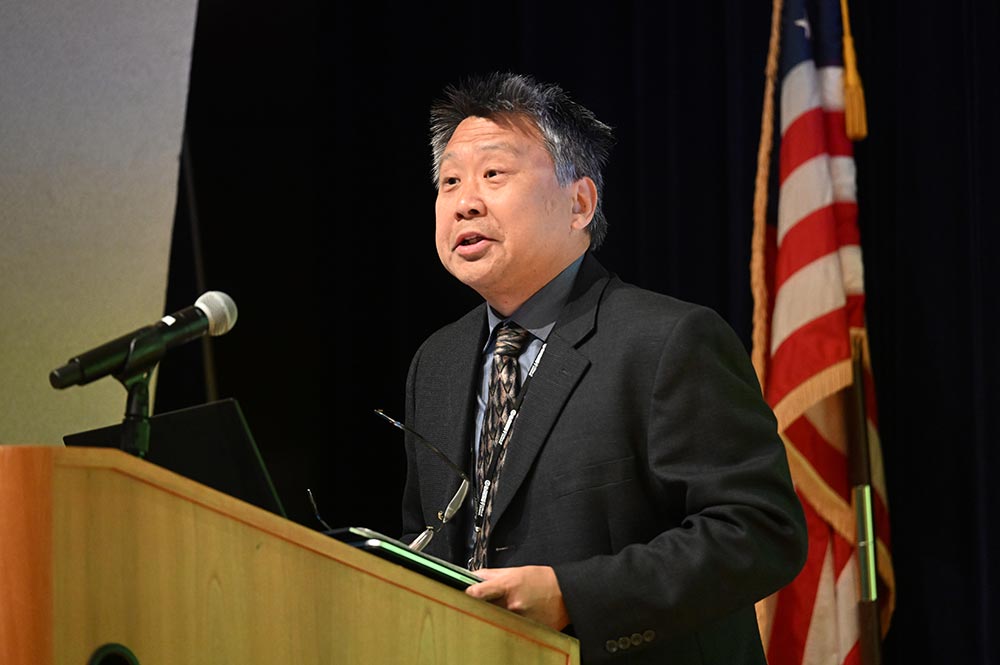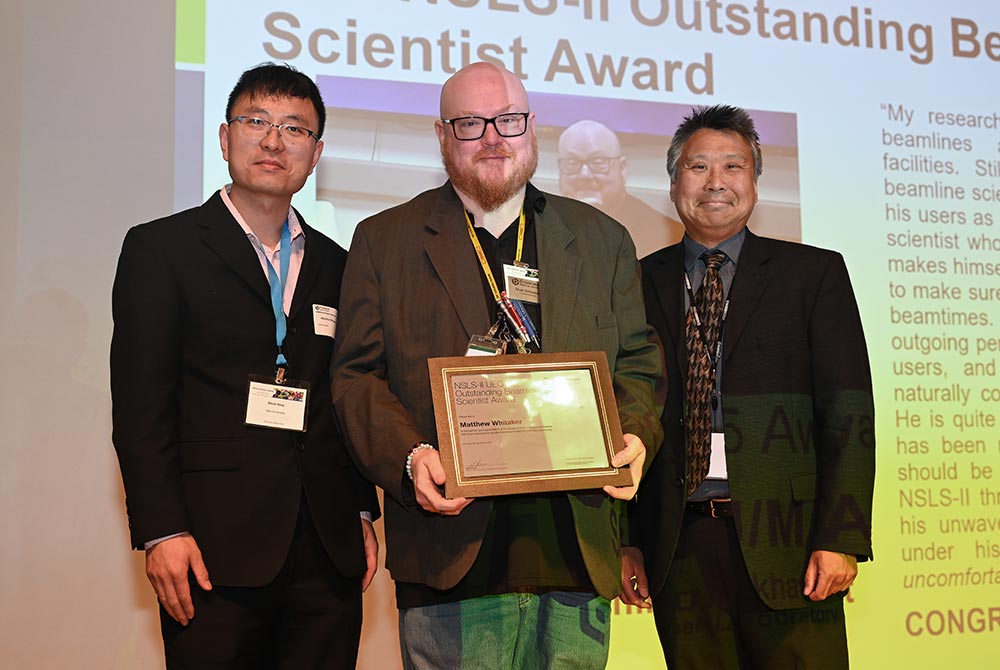Passing on the Torch
Meet Wilson Chiu, the NSLS-II UEC's newest chair, as he takes the reins from his predecessor, Matthew Whitaker
May 27, 2025

National Synchrotron Light Source II Users' Executive Committee Chair Wilson Chiu addresses the audience at the plenary session of this year's Users' Meeting. (Kevin Coughlin/Brookhaven National Laboratory)
At this year’s National Synchrotron Light Source II (NSLS-II) and Center for Functional Nanomaterials (CFN) joint users’ meeting, the Users’ Executive Committee (UEC) announced their newly elected Chair, Wilson Chiu. Chiu, a longtime NSLS-II user, is currently a professor in the School of Mechanical, Aerospace and Manufacturing Engineering at the University of Connecticut. His research focuses on heat and mass transfer in advanced materials for energy applications. After serving as Vice Chair, Chiu looks forward to representing NSLS-II’s dynamic user community in this new leadership role.
Congratulations on your new role as Chair! How did this journey start?
I have to take a few steps back here. I actually started as a user back at the original National Synchrotron Light Source (NSLS). This was towards the end of the facility’s run, before we moved over to NSLS-II. I started becoming a more regular user there. I was also using the imaging beamlines at the Advanced Photon Source, a U.S. Department of Energy (DOE) user facility at DOE’s Argonne National Laboratory, and the Stanford Synchrotron Radiation Light Source, a DOE user facility at DOE’s SLAC National Accelerator Laboratory, when they initially set up their X-ray microscopes. When NSLS-II constructed their Hard X-ray Nanoprobe and Full Field X-ray Imaging beamlines, I continued my research there. It ended up being a really nice collaboration.
I realized that as a regular user, I was able to engage other scientists and other engineers that may be interested in using these facilities. I often found myself explaining the process to get started, the accessibility, and the capabilities to fellow researchers. I also encouraged beamline scientists here to give talks at conferences where they could reach different user communities. It was nice to be able to use the experiences I’ve had to help others pave their way. The UEC gave me a venue to do that.
Tell us a little bit more about your research.
I’ve always been focused on what people commonly refer to as “energy materials” and different types of related technologies. Early in my career, I was focused on fuel cell and electrolyzer materials. More recently, my work has focused on nuclear energy. I’m part of a large team trying to help create the next generation of technologies for nuclear reactors for electricity generation. It’s really exciting.
Why did you get involved with the UEC?
To me, joining the UEC was a wonderful opportunity to give back to the community, to lend them a voice and express any concerns or issues that we may have. I want to be part of the conversations that help steer the facility in terms of scientific capabilities, like the upcoming science workshops. I want to ensure that these meetings address the needs of scientific researchers. To me, that’s really important because these facilities are no easy feat to build, right? When planning something like a new beamline, it's essential for the user community to provide their input early on. As an example, for some of the nuclear energy research we're doing now, there are capabilities that don’t exist yet that we’d like to see. Some are just starting to develop.
So, who is Wilson Chiu outside of the Lab? What do you like to do when you’re not focused on science?
That’s a good question. It’s the kind of work that requires intense focus, so it’s beneficial to distract yourself and come back with a fresh perspective every once in a while. When I’m not focused on my own research, I’m actually interested in other areas of science. For example, I’m fascinated by what our last chair, Matt Whitaker, is working on. Geology is really interesting. The more I find out, the more questions I have. I just really enjoy learning new things. Other than that, I do enjoy tennis and playing pickleball with my wife.
If you could let the user community know one thing about your work with the UEC, what would it be?
We're here to help you. Reach out anytime, from anywhere. Matt and I are both researchers. I'm an engineer, he's a scientist, but we both understand how challenging research can be. Every success I’ve earned has had some failures behind it. I just experienced a major one very recently and lost almost half a week of beam time! We understand the kinds of things all researchers are going through, and we're here to help improve what we can and give you a platform to share your experiences.
What do you hope to accomplish as UEC Chair?
I really hope to make a difference. I hope my actions and involvement can help the UEC continue to effectively represent the user community, build strong relationships with NSLS-II staff, expand the community, and improve the overall experience of users. Speaking of, before we hand it off to Matt, I want to congratulate him again on receiving the NSLS-II UEC’s Outstanding Beamline Scientist Award this year. It’s well deserved.

Matthew Whitaker (center) accepts the NSLS-II Outstanding Beamline Scientist Award from Wilson Chiu (right) and Shize Yang (left) at this year's user meeting (Kevin Coughlin/Brookhaven National Laboratory)
Matthew Whitaker is a Research Associate Professor at Stony Brook University in the Mineral Physics Institute and Department of Geosciences. He’s been a Beamline Scientist for about 15 years, operating the high pressure endstations first at X17B2 of NSLS, and now at 6-BM-B at the Advanced Photon Source and the Multi-Anvil X-ray Powder Diffraction (MAXPD) endstation at the X-ray Powder Diffraction (XPD) beamline at NSLS-II. Matt is also the PI of the Stony Brook Multi-Anvil X-ray facility program of the National Science Foundation Synchrotron Earth and Environmental Science (NSF-SEES), which operates both of these beamline programs.
Hi Matt! You’ve been on the NSLS-II UEC for a while now. How did you first get involved?
Back in the pre-COVID era, which I like to refer to as the “Before Times” of early 2019, I ran for election to the UEC for the first time. A month later, I somehow managed to get elected as Vice Chair and the rest, as they say, is history. I’ve been a user at Brookhaven Lab since around 2002, and a partner user and beamline scientist there since 2011. After all that time, I wanted to get more involved and share some ideas that were a little more outside of the box. It’s been a long and wild ride on the UEC, for sure, but I’m looking forward to taking a step back and seeing the great things the UEC will do without me. We’ve instituted term limits, so that the UEC had no choice but to get rid of me. But, just like every parent wants to see the next generation do and be better than the generation before, I’m excited to see what Wilson will do, so the future is bright!
On the topic of unconventional ideas, tell us a little bit about the UEC Show?
Right after I joined the UEC, as in two days into my tenure, I was invited to a meeting with the media department. I had no idea what was going on. The only thing that I knew is that the year before, the UEC wanted to discontinue the town hall meetings or find a new approach to them, as the attendance was fairly low. The team wanted it to feel more conversational, which led to us spit balling all kinds of ideas until we landed on this talk show-esque format. Initially there were quite a few of us that thought, “we can’t do that,” but the more we talked about it, the more we wanted to make it happen. That’s how the UEC Show developed. I think people really enjoyed bringing it to life, and we were given more creative leeway than I think any of us expected. We took advantage of every inch we were given, and made something not only unique, but something other places have started to emulate. We certainly enjoy making it, even with all of the work that goes into it. It gives us an outlet to be able to do something fun and ridiculous while also bringing helpful information to the users.
In your time as UEC Chair, what’s one important takeaway you’d like to share?
I wanted to emphasize that we’re here to foster relationships and dialogues — it’s always a two-way street. It’s not just about us finding answers for you but finding the right people to start conversations and build relationships with. Communication is always a hurdle in any facility or organization, and that happens to be one thing I am good at (or at least I like to think that I am). During the users’ meeting, Lab Director JoAnne Hewett called users the “lifeblood” of facilities like this. I like to think of the UEC as the heart trying to get that lifeblood to the brain effectively. I think I may be too deep in the metaphors now, but the point rings true.
Like the question posed to Wilson earlier, what is your life like outside of the Lab?
It depends on who’s asking. I joke, of course. Predominantly, I’m a father to some pretty awesome kids. The eldest is now 14; she’s in high school, so my life is officially over. The Twinnakers (the chosen monicker of my twins) just turned eight, and they’re a lot of fun. As for me? I have a mostly healthy video game hobby that gives me an hour or few to unwind after the kids are off to dreamland for the night. When it comes to saving humanity from encroaching other-worldly threats, I proudly do my part. On most weekends, though, I sing in a couple of pretty awesome bands and have a good time doing that. It’s also how I earn the money to keep up my convenience store soda habit. If you know, you know.
Brookhaven National Laboratory is supported by the Office of Science of the U.S. Department of Energy. The Office of Science is the single largest supporter of basic research in the physical sciences in the United States and is working to address some of the most pressing challenges of our time. For more information, visit science.energy.gov.
Follow @BrookhavenLab on social media. Find us on Instagram, LinkedIn, X, and Facebook.





